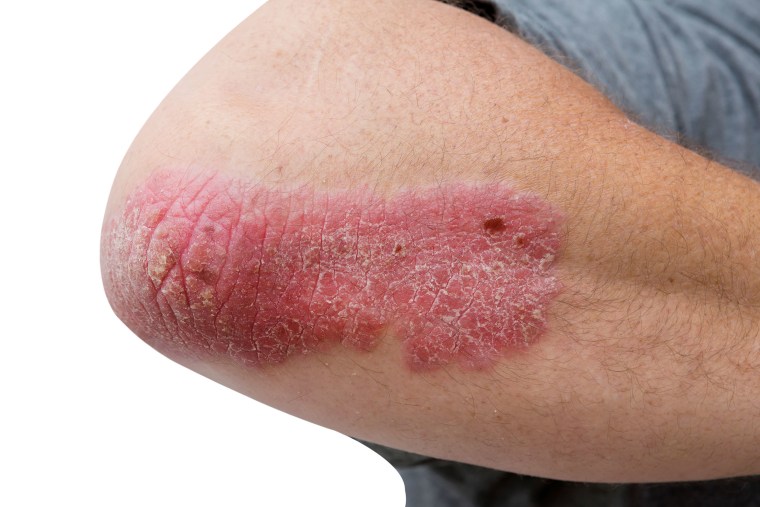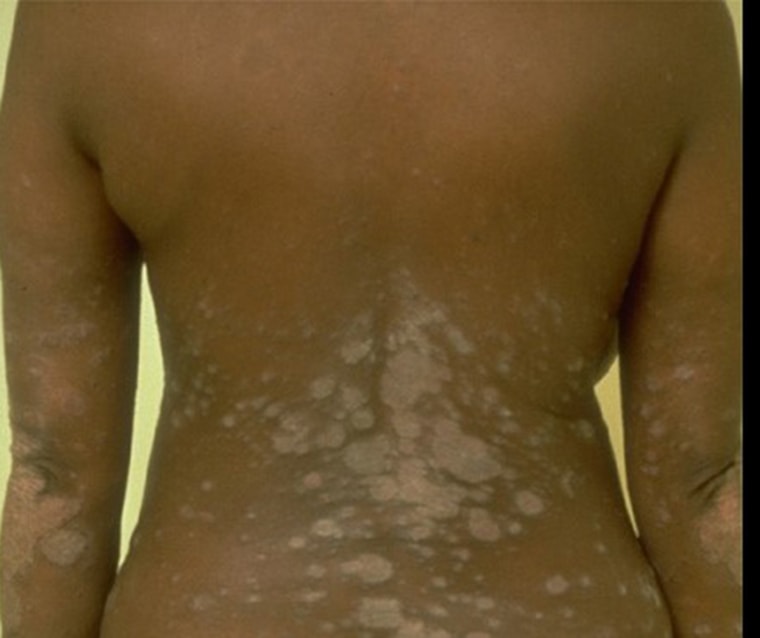What is psoriasis? Psoriasis is a skin condition where your body makes new skin cells quickly. In about 80 to 90% of people with psoriasis, these skin cells build up in thick, scaly patches called psoriasis plaques, according to the American Academy of Dermatology (AAD). The condition is not contagious.
More than 8 million people in the U.S. have psoriasis, and it usually starts in the teen years or early 20s, though it can strike at any age, reports the National Psoriasis Foundation (NPF). It can develop in people of any race, and is more common in people who have a family member with the condition.
Dr. Carolyn Jacob, medical director of Chicago Cosmetic Surgery and Dermatology and a member of the American Academy of Dermatology (AAD), was diagnosed with psoriasis 36 years ago. “It’s what got me into dermatology,” she said.
Untreated, people with psoriasis can leave a trail of unsightly scales that make them want to stay home. “Most people don’t care for that,” said Dr. Amy McMichael, chair of the dermatology department at Wake Forest Baptist Health in North Carolina and a member of the American Academy of Dermatology. “Now we can get those patients to where they have a very manageable disease.”
Symptoms of psoriasis
Most people with psoriasis develop itchy, scaly plaques that are usually white or silver. They often crop up on the knees, elbows, lower back or scalp. On the scalp, they can spread to psoriasis of the face.
Less-common types of psoriasis can cause tiny pink bumps, skin that’s sore and red, pus-filled bumps on the hands and feet or other skin problems. You can have more than one type of psoriasis.
It’s also possible to have psoriasis with arthritis, where the psoriasis affects the joints. According to the NPF, 30 percent of people with psoriasis will go on to develop psoriatic arthritis.
Causes of psoriasis
What causes psoriasis? The immune system plays a role. With psoriasis, the white blood cells, or T-cells, in the body’s immune system attack the skin cells. The body responds by making more skin cells, which build up on top of the skin.
There’s also a genetic factor behind who gets psoriasis. But some people get psoriasis even though they don’t have the genes that increase their risk, according to the AAD. And it’s possible that some people who do have the genes that increase their risk never develop psoriasis. Researchers think exposure to a trigger might kickstart psoriasis in people who are more likely to develop it.
There are certain triggers that can cause psoriasis for the first time. These triggers can also cause psoriasis flare-ups.
Triggers linked with psoriasis, according to the AAD:
- Stress
- Sunburns or skin injuries
- Infections
- Medications
- Cold, dry weather
- Tobacco
- Drinking alcohol
Not every trigger causes flare-ups in every person with psoriasis, so it’s important to watch your symptoms and try to determine what could be causing them.

Diagnosing psoriasis
Your dermatologist will look over your skin, nails and scalp to check for signs of psoriasis, and ask about your symptoms, joint problems, family history and possible triggers.
“There may be less erythema (redness) in the lesions, so the lesions often look violaceous or hyperpigmented (in darker skin),” said McMichael, adding that psoriasis lesions may also be more hyperkeratotic and thick in the skin of Black people with the condition.
Examining a skin sample under a microscope can help confirm a psoriasis diagnosis.

Treatment for psoriasis
Psoriasis is almost always a lifelong condition. “We don’t have a cure, but we have many medications now that can make you feel like you don’t have psoriasis,” Jacob said. “The medications have advanced so far since when I was diagnosed — they used to call it ‘the heartbreak of psoriasis.'”
McMichael recalls an 18-year-old patient with severe psoriasis — the plaques covered her body and she needed a wheelchair to get around. “She had been through all the medications we had. Now you never see a patient like that,” she said. Today, if one medication doesn’t work there are a lot more to try. “That has made the lives of psoriasis patients so much easier,” she said.
According to the NPF, psoriasis treatment options include:
- Biologics that target the immune system
- Medications that you take by mouth
- Light therapy
- Topicals such as creams and ointments
- Alternative treatments, such as mind-body practices, pain management and lifestyle changes
- For scalp psoriasis, medicated shampoos
While today’s treatments are highly effective, it’s often necessary to use a combination of different treatments to achieve clear — or nearly clear skin — and sometimes it can take months, or even years, to find a treatment regimen that works well for you, according to the NPF. But reducing your psoriasis is an important goal. Not only will it make your skin feel better, it’ll help improve your overall health, including any depression that may be related to your psoriasis; it can also reduce your risk of other conditions, such as diabetes and cardiovascular disease.
People with psoriasis and their providers can use the NPF’s treatment targets for guidance on how soon results can be expected when trying out medication options. The NPF says that after 3 months on a medication, psoriasis should only appear on 1% or less of your body surface area, though 75% improvement is also acceptable. But if you haven’t reached 1% or less psoriasis on your body after 6 months on the treatment regimen (and if you haven’t had an acceptable response after 3 months), the NPF recommends discussing other treatment options with your doctor.
Additionally, if you’ve achieved success with a treatment regimen, but it stops working well, talk to your doctor about finding another treatment solution for your psoriasis.
“It’s one of my favorite skin conditions to treat because there are so many options to make it better,” Jacob said. “The new biologics work so well we can get people’s skin clear so they feel like they don’t have psoriasis — I forget I have it now.”

